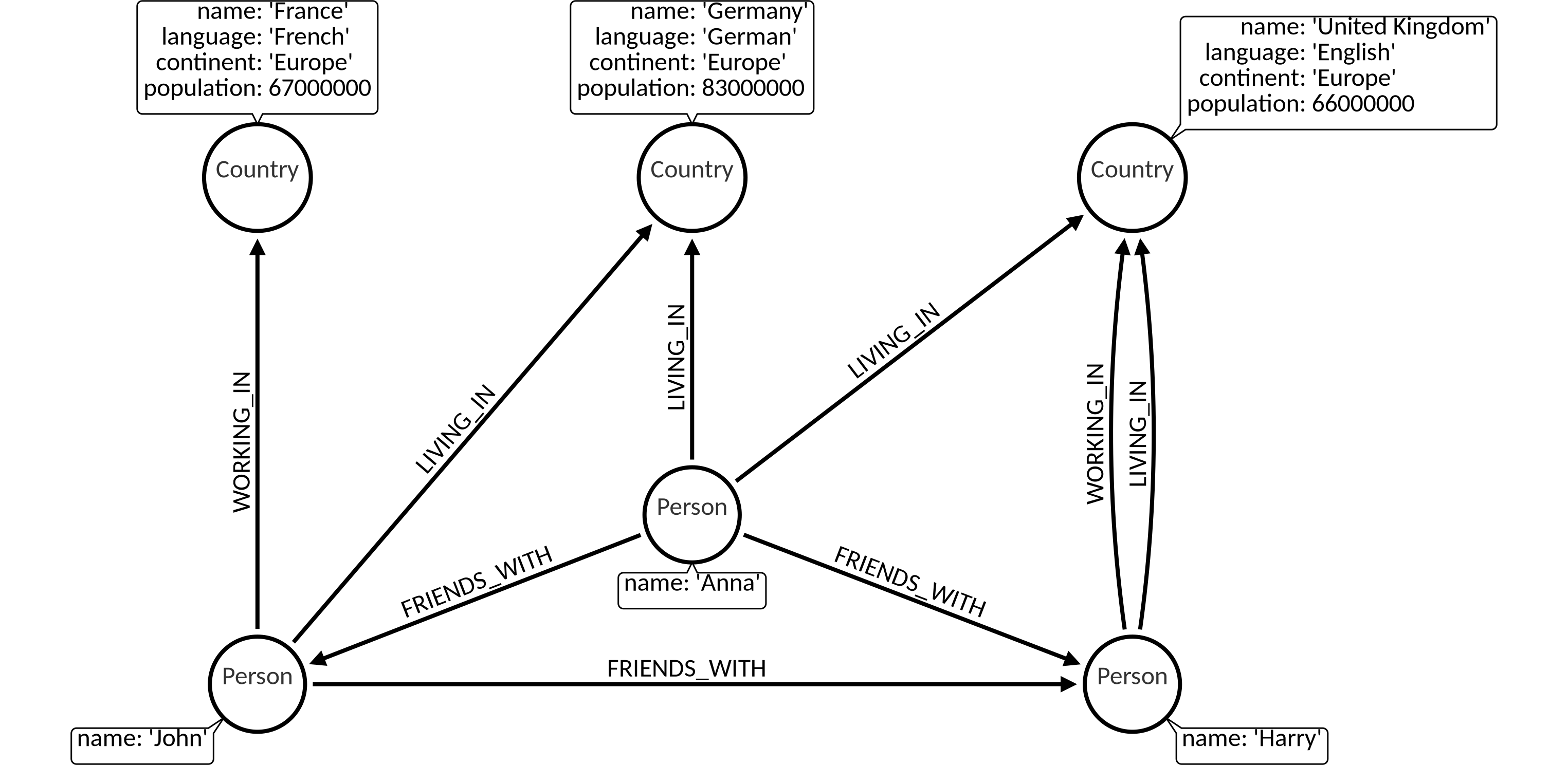REMOVE clause
The REMOVE clause is used to remove labels and properties from nodes and relationships.
Dataset
The following examples are executed with this dataset. You can create this dataset locally by executing the queries at the end of the page: Dataset queries.

1. Removing a property
The REMOVE clause can be used to remove a property from a node or relationship:
MATCH (n:Country {name: 'United Kingdom'})
REMOVE n.name
RETURN n;Output:
+-----------------------------------------------------------------------------+
| n |
+-----------------------------------------------------------------------------+
| (:Country {continent: "Europe", language: "English", population: 66000000}) |
+-----------------------------------------------------------------------------+The REMOVE clause can’t be used to remove all properties from a node or relationship. Instead, take a look at the SET clause.
2. Removing a label
The REMOVE clause can be used to remove a label from a node:
MATCH (n:Country {name: 'United Kingdom'})
REMOVE n:Country
RETURN n;Output:
+--------------------------------------------------------------------------------------------+
| n |
+--------------------------------------------------------------------------------------------+
| ({continent: "Europe", language: "English", name: "United Kingdom", population: 66000000}) |
+--------------------------------------------------------------------------------------------+Let’s add the label Country back to the node with the name United Kingdom and the additional label Kingdom.
MATCH (n {name: 'United Kingdom'})
SET n:Country:Kingdom;You can now remove multiple labels from a node at the same time.
MATCH (n:Country {name: 'United Kingdom'})
REMOVE n:Country:Kingdom
RETURN n;Output:
+--------------------------------------------------------------------------------------------+
| n |
+--------------------------------------------------------------------------------------------+
| ({continent: "Europe", language: "English", name: "United Kingdom", population: 66000000}) |
+--------------------------------------------------------------------------------------------+Dataset queries
We encourage you to try out the examples by yourself. You can get our dataset locally by executing the following query block.
MATCH (n) DETACH DELETE n;
CREATE (c1:Country {name: 'Germany', language: 'German', continent: 'Europe', population: 83000000});
CREATE (c2:Country {name: 'France', language: 'French', continent: 'Europe', population: 67000000});
CREATE (c3:Country {name: 'United Kingdom', language: 'English', continent: 'Europe', population: 66000000});
MATCH (c1),(c2)
WHERE c1.name= 'Germany' AND c2.name = 'France'
CREATE (c2)<-[:WORKING_IN {date_of_start: 2014}]-(p:Person {name: 'John'})-[:LIVING_IN {date_of_start: 2014}]->(c1);
MATCH (c)
WHERE c.name= 'United Kingdom'
CREATE (c)<-[:WORKING_IN {date_of_start: 2014}]-(p:Person {name: 'Harry'})-[:LIVING_IN {date_of_start: 2013}]->(c);
MATCH (p1),(p2)
WHERE p1.name = 'John' AND p2.name = 'Harry'
CREATE (p1)-[:FRIENDS_WITH {date_of_start: 2011}]->(p2);
MATCH (p1),(p2)
WHERE p1.name = 'John' AND p2.name = 'Harry'
CREATE (p1)<-[:FRIENDS_WITH {date_of_start: 2012}]-(:Person {name: 'Anna'})-[:FRIENDS_WITH {date_of_start: 2014}]->(p2);
MATCH (p),(c1),(c2)
WHERE p.name = 'Anna' AND c1.name = 'United Kingdom' AND c2.name = 'Germany'
CREATE (c2)<-[:LIVING_IN {date_of_start: 2014}]-(p)-[:LIVING_IN {date_of_start: 2014}]->(c1);
MATCH (n)-[r]->(m) RETURN n,r,m;